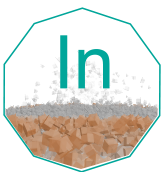Indium

Indium (In)
General Information
- Symbol: In
- Atomic Number: 49
- Atomic Weight: 114.818 u
- Element Category: Post-transition metal
- Group: 13
- Period: 5
- Block: p-block
Physical Properties
- Appearance: Silvery-white metallic
- Density: 7.31 g/cm³
- Melting Point: 156.60 °C (313.88 °F)
- Boiling Point: 2072 °C (3762 °F)
- Phase at STP: Solid
- Electron Configuration: [Kr] 4d¹⁰ 5s² 5p¹
- Oxidation States: +3 (most common), +1
Chemical Properties
- Reactivity: Moderately reactive; does not tarnish quickly in air, but can form a thin layer of indium oxide.
- Compounds: Forms compounds such as indium(III) oxide (In₂O₃), indium(I) chloride (InCl), and indium(III) chloride (InCl₃).
Uses and Applications
- Electronics: Widely used in indium tin oxide (ITO) for touch screens, flat panel displays, and solar panels due to its transparency and conductivity.
- Semiconductors: Used in semiconductor devices, particularly in indium phosphide (InP) and indium antimonide (InSb).
- Alloys: Used in low-melting-point alloys, often for solders and special fusible alloys.
- Coatings: Used as a coating material for bearings and other mechanical components to reduce wear and corrosion.
- Nuclear Technology: Used in control rods and other components due to its ability to absorb neutrons.
Occurrence and Extraction
- Natural Occurrence: Found in zinc ores such as sphalerite, and in iron, lead, and copper ores.
- Extraction: Typically extracted as a byproduct of zinc refining through processes such as roasting and leaching.
Isotopes
- Stable Isotopes: Indium-113 (4.29%) and Indium-115 (95.71%)
- Radioactive Isotopes: Indium-111 (used in medical diagnostics and imaging)
Safety and Handling
- Hazards: Generally considered to be of low toxicity, but indium compounds can be toxic if ingested or inhaled in large quantities.
- Precautions: Handle with care, using appropriate protective equipment, especially in powder form to avoid inhalation.
History
- Discovery: Discovered by Ferdinand Reich and Hieronymous Theodor Richter in 1863.
- Name Origin: Named after the indigo line in its spectrum.
Additional Facts
- Crystal Structure: Tetragonal
- Magnetic Properties: Diamagnetic
- Thermal Conductivity: Moderate, about 81.6 W/m·K
- Electrical Resistivity: About 83.7 nΩ·m at room temperature
Summary
Indium is a post-transition metal known for its use in electronics, semiconductors, low-melting-point alloys, and coatings. It is extracted as a byproduct of zinc refining and has two stable isotopes. Indium’s unique properties, such as its transparency and conductivity, make it valuable in modern technology applications, especially in touch screens and solar panels.
40 Question and Answer Pairs About Indium
What is the atomic number of Indium?
- 49
What is the symbol for Indium?
- In
What is the atomic weight of Indium?
- 114.818 u
In which group of the periodic table is Indium found?
- Group 13
What period is Indium in?
- Period 5
What block does Indium belong to?
- p-block
What is the melting point of Indium?
- 156.60 °C (313.88 °F)
What is the boiling point of Indium?
- 2072 °C (3762 °F)
What is the density of Indium?
- 7.31 g/cm³
What is the electron configuration of Indium?
- [Kr] 4d¹⁰ 5s² 5p¹
What are the common oxidation states of Indium?
- +3, +1
What is the appearance of Indium?
- Silvery-white metallic
Does Indium tarnish in air?
- It forms a thin layer of indium oxide but does not tarnish quickly.
Name a compound of Indium.
- Indium(III) oxide (In₂O₃)
What is a common use of Indium in electronics?
- In indium tin oxide (ITO) for touch screens and flat panel displays
How is Indium used in semiconductors?
- In indium phosphide (InP) and indium antimonide (InSb)
What role does Indium play in alloys?
- Used in low-melting-point alloys for solders and fusible alloys
How is Indium used in coatings?
- As a coating material for bearings and other mechanical components
What application does Indium have in nuclear technology?
- Used in control rods due to its neutron-absorbing ability
Name a mineral that contains Indium.
- Sphalerite
How is Indium extracted from ores?
- As a byproduct of zinc refining through roasting and leaching
What is the most stable isotope of Indium?
- Indium-115
Name a radioactive isotope of Indium used in medical applications.
- Indium-111
What safety hazard is associated with Indium compounds?
- They can be toxic if ingested or inhaled in large quantities
Who discovered Indium?
- Ferdinand Reich and Hieronymous Theodor Richter
Where does the name Indium come from?
- Named after the indigo line in its spectrum
What is the crystal structure of Indium?
- Tetragonal
Is Indium paramagnetic or diamagnetic?
- Diamagnetic
What is the thermal conductivity of Indium?
- About 81.6 W/m·K
What is the electrical resistivity of Indium at room temperature?
- About 83.7 nΩ·m
What is the primary oxidation state of Indium?
- +3
Is Indium found as a free element in nature?
- No, it is found in ores with other metals
What is the common name of indium(I) chloride?
- InCl
What is a major application of indium(III) chloride (InCl₃)?
- Used in chemical synthesis and catalysis
How does Indium benefit touch screens?
- It provides transparency and conductivity
What is the boiling point of Indium in Kelvin?
- 2345 K
What group does Indium belong to in the periodic table?
- Post-transition metals
What is the natural abundance of Indium-115?
- About 95.71%
Can Indium be used in high-temperature applications?
- Yes, in specific alloys and coatings
What is the key property that makes Indium valuable in electronics?
- Its transparency and conductivity in indium tin oxide (ITO).






